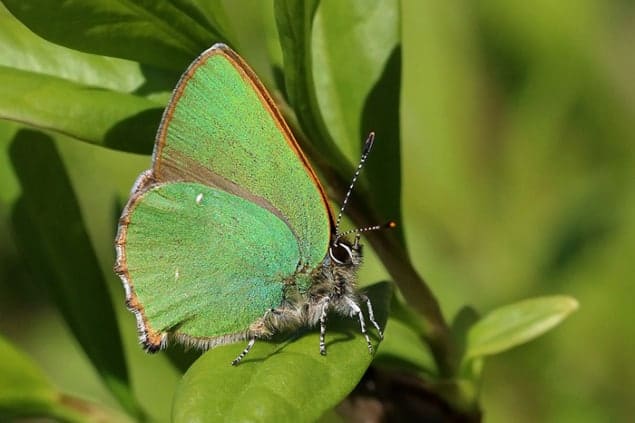
An artificial material with the eye-catching optical properties of the Callophrys rubi butterfly has been created by researchers in Australia. Using a special lithography technique, the team was able to make photonic “gyroid” nanostructures similar to those found in the butterfly’s wings. The artificial structures, which outperform their natural counterpart in many ways, could find use in a variety of photonics and optics technologies.
Gyroids are 3D periodic structures made up of intertwining, curved surfaces. They have lattice constants that are comparable to the wavelength of visible light, which means that they have a range of optical properties, such as structural colour. This is what gives the Callophrys rubi butterfly a beautiful blue-green sheen on its wings. Thanks to their cubic symmetry and the fact that they are mechanically strong, gyroids could also be ideal for making photonic crystals and other optical metamaterials. These are artificial structures that have a number of desirable optical properties that make them ideal for controlling light in technologies such as optical communications and displays.
Stronger and better defined
However, the techniques employed to make optical metamaterials have been unable to produce artificial gyroid structures with lattice constants comparable to those found in butterfly wings. Now, a team led by Min Gu of RMIT in Melbourne has used a technique called optical two-beam super-resolution lithography to create 3D gyroid structures with lattice constants of 360 nm. This gives the artificial gyroids a similar blue-green colour to the butterfly’s wing. However, the artificial structures are mechanically stronger than natural gyroids, and have long-range periodicities and well-defined crystalline boundaries. The latter two properties are lacking in natural materials, which suffer from uncontrolled structural disorders.
Another unique feature of the artificial gyroids is that they have chiral properties that are lacking in the imperfect natural structures. An artificial structure, for example, will contain only left- or right-handed single gyroid enantiomers, while the natural version contains a mixture of both. This means that the artificial gyroids are much more suitable for applications such as photonic crystals with optical band gaps and miniature chiral beam splitters. Metamaterials made from the artificial gyroids are expected to have tuneable nonlinear optical properties and respond to light at ultrafast speeds, so making them ideal for high-speed optical switches.
Apart from applications in photonics, the new gyroid structures could help make more compact optoelectronics because, thanks to their smaller size, larger numbers of devices can be integrated onto a single chip. According to Gu, the superior mechanical strength of the artificial material makes it well-suited for high levels of integration.
The research is detailed in Scientific Advances.
- A version of this article first appeared on nanotechweb.org



